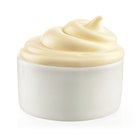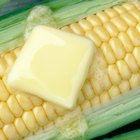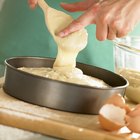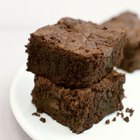
Fat and sugar are among the most important ingredients in cakes, because they contribute to the softness and richness of the crumb. Unfortunately, there are limits to how much sugar and conventional fat -- such as shortening or butter -- you can add to a cake batter. Commercial bakers get around this by using special shortenings with added emulsifiers, such as lecithin, referred to as emulsified or high-ratio shortenings. Those shortenings enable you to use professional-style recipes and make commercial-quality cakes.
Matchmaker, Matchmaker
Underneath its familiar appearance, cake batter is a complex emulsion of water-based ingredients, such as milk and egg whites, with fat-based ingredients, such as butter or shortening. Oil and water don't ordinarily mix, but emulsifiers in your recipe's egg yolks solve that problem by acting as a sort of molecular matchmaker. The end result is a very smooth batter and a cake with good texture. However, eggs alone can't emulsify the high levels of sugar and fat called for in commercial baking. Industrial bakeries add extra emulsifiers separately, but small bakeries and pastry chefs use emulsified shortening to make these so-called "high-ratio" cakes.
High-Ratio Cakes
Emulsified or high-ratio shortening has extra emulsifiers added to it during manufacturing. Every 10 ounces of shortening includes roughly 1/3 ounce of emulsifiers, which help the shortening combine easily into the cake batter. That makes it possible for neighborhood bakeries, or even home bakers, to make cakes as light and delicate as the ones from commercial manufacturers. If you want to try a professional high-ratio recipe at home, you can make a few phone calls and wheedle some emulsified shortening from a baker in your area. Alternatively, online vendors and baking-supply outlets stock a few brands in retail sizes ranging from 1 to 4 pounds, like regular shortening.
Doing the Two-Step
The special process used to make these high-ratio cakes is called the two-step or two-stage method. In the first step, the dry ingredients are whipped together with the shortening and eggs to make a paste. This distributes the emulsifiers from the eggs and shortening throughout the mixture. Next, the liquid ingredients and flavorings are added and mixed briefly until they're combined into a thin, smooth batter that's ready for baking. Commercial boxed cake mixes are made through a similar process, though it results in a dry mixture rather than a paste. When you add the oil and liquid ingredients, you're essentially completing the second stage of a two-step cake batter.
Making it Pretty
Emulsified shortenings have one other characteristic that endears them to cake bakers. When your cake is finished and ready to decorate, they can be whipped up into an unusually light, creamy and spreadable icing. This shortening-based icing doesn't taste as good as a true buttercream, but it's a beautifully pure white and is also much more stable in warm or humid environments. Its purity of color also means it can easily be tinted for decorations, helping to make the cake even more appealing.
Related Articles

How to Add Meringue Powder to ...

Does Adding an Extra Egg to Brownie Mix ...

Applesauce as an Egg Substitute for ...

Can I Use Mayo Instead of Eggs to Make ...

Do You Still Need Baking Powder & Salt ...

How to Thicken Cake Batter

Cake Emulsifier Substitute

How to Make Frosting Hard for a Cake

Common Food Emulsifiers

Do Eggs Make Baked Goods Rise?

Adding Cream of Tartar to Macaroons

Cream of Tartar Substitute for Egg ...

How to Use Shortening Instead of Oil ...

How to Make a Box Cake Mix Taste Better

What Kind of Oil Do You Use in Brownie ...
Does Cake Flour Contain Baking Soda & ...

What Are the Functions of Flour in ...

Softened vs. Melted Butter When Baking

How Much Melted Shortening Do I Use in ...

A List of Leavening Agents
References
- On Food and Cooking: The Science and Lore of the Kitchen; Harold McGee
- The Professional Pastry Chef; Bo Friberg
Resources
Writer Bio
Fred Decker is a trained chef and prolific freelance writer. In previous careers, he sold insurance and mutual funds, and was a longtime retailer. He was educated at Memorial University of Newfoundland and the Northern Alberta Institute of Technology. His articles have appeared on numerous home and garden sites including GoneOutdoors, TheNest and eHow.
Photo Credits
Jupiterimages/Stockbyte/Getty Images